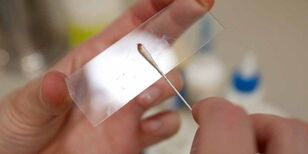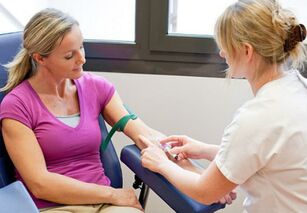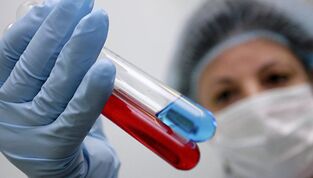What tests should be done to identify worms?
Tests for worms must be carried out regularly in order to identify the disease in a timely manner. The most famous of these is the analysis of feces, which is carried out before work or visiting a sanatorium. However, this is not the only, and is not the most reliable, method of identifying parasites. A combination of tests gives the most accurate answer.
What tests are there for worms?
The list of tests that must be carried out to identify parasites is quite long.
The most important are:
- Fecal analysis, also known as worm eggs, is the most common method. Advantages - massive effort, no complex equipment required. Minus - lack of accuracy;
- ELISA, also known as the blood test for worms. Advantages - high accuracy. Disadvantages - shows only certain stages of parasite development, at other times the result is questionable;
- Analysis of other biological media (urine, sputum, duodenal contents, epidermis). Advantages - Allows parasites to be identified in locations that are not available for other analysis. Disadvantages - associated with considerable inconvenience for the patient.
Typically, a patient is prescribed a combination of several tests to identify the parasite. The criterion for recovery is considered a negative ELISA result and multiple negative results from the study of the biological environment in which the worms were detected.
Analysis of feces for worm eggs
Most worms live in the gut, so the most common test for worms is the stool test. It is prescribed for routine medical examinations for adults and children before being taken to a sanatorium or children's camp as part of a health book during hospitalization. This analysis is also carried out by people who have had contact with infected patients, who have eaten untested foods and who have noticed characteristic symptoms of worms.

It is not necessary to prepare specifically for the analysis. You can collect droppings at any time of the day. However, the most significant is the morning droppings. Immediately before delivery, you should wash the perineum to avoid urine contamination and discharge from the genitals.
Feces to be analyzed for worms are collected in a special container. It is sealed and a special spoon is attached to collect the material. To collect the most informative part of the material, you need to take a sample from the center of a portion of feces. The container must be about a third full. You have to bring it to the lab on the same day.
In the laboratory, a specialist examines the feces under a microscope and identifies worm eggs in it. Most of them have a distinctive shape that allows you to accurately determine the type of worm. Based on the results of the analysis, a conclusion is drawn about the absence of eggs or about their presence and type, after which treatment is prescribed.
This is the most common, but least accurate, worm test. This is because there may not be eggs in the serving that got into the container, even though there are worms. Therefore, if the patient complains of characteristic symptoms or has come into contact with the source of infection, then 5-6 tests must be carried out with an interval of 2-3 days. In this case, the likelihood of detecting parasites is significantly increased. Along with the examination of feces, other diagnostic procedures are prescribed.
Skin scratching

This analysis usually supplements the stool analysis. The most accurate result is obtained when diagnosing pinworms, which lay eggs on the surface of the skin near the anus. Indications for such an analysis are routine examinations of children and adults, registration of a child in a kindergarten, school, camp or sanatorium, hospitalization of children and adults, suspected pinworm infection (itching in the anus, indigestion, contact with the sick). Most often children suffer from this disease, which explains the name of the worm (child worm).
You don't need to prepare to be analyzed for worms. You shouldn't wash the perineum. So it is possible to wash the eggs from parasites. You don't have to bathe or shower the night before. The analysis takes place in the morning. A special film is used that collects material from the skin of the intergluteal fold. The study is also carried out under a microscope. Helminthiases other than pinworms are not recognized.
Urinalysis
This test is the least prescribed because parasites almost never live in the urine. Situations are possible if pinworms are found when analyzing the urine. But this indicates a violation of the rules for passing the analysis - parasites and their eggs get into the container from the skin of the perineum. Most often this situation occurs in girls, less often in boys.
Nevertheless there are tips for testing. Some tropical parasites live in the kidneys and urinary organs, which "rewards" a person by traveling to Asian and African resorts. With the increasing availability of exotic recreational areas, the spread of parasites, which are atypical for our country, also increases. For this reason, it is advisable to have a urine and blood test for worms after a trip to the resorts.
Types of worms in the urine:
- Trichomonas;
- Distomum haematobium;
- Filaria sanguinis hominis;
- Taqnia echinococcus.
Also in the urine there can be eggs from liver parasites - Echinococcus and leeches.
Sputum analysis
There are a number of parasites that spend all or part of their life in the lungs. The symptomatology of their appearance is not typical - catarrhal phenomena (inflammation, cough, wheezing) develop in the bronchi. Hemoptysis, pneumonia of unknown origin and other phenomena from the lungs can be detected.
Parasites detected by the sputumworm test:
- Ascaris - in the larval stage they need oxygen;
- Echinococci and alveococci - tissue parasites that live in parenchymal organs, including the lungs;
- dwarf coincidence - lives mainly in the lungs;
- Strongyloidosis, non-katorosis - parasitosis, characterized by intestinal localization, the position in the lungs is atypical
No special preparation is required to collect sputum. However, it is advisable to brush your teeth and take the material in the morning. Before that, it makes sense to drink plenty of fluids - this will improve the expectoration of sputum. The collection container must be clean, but not necessarily sterile - bacteria do not play a role in diagnosis. In this case, both the parasites themselves and their eggs are detected. If the patient is unable to cough up mucus, vacuum suction is used to remove it from the trachea.
It is possible to use drugs that improve the outflow of sputum and stimulate its formation in order to get more accurate results of the analysis for worms. In combination with a blood test for worms, the results are very accurate. In contrast to stool exams, eggs are more likely to be found.
blood test

ELISA or blood test for worms - the most accurate method for their determination. Helminths trigger a strong reaction of the immune system - the content of eosinophils increases, the production of immunoglobulins increases and specific antibodies against parasites appear. If they are detected, the ELISA method is set up.
Antibodies to parasites are extremely specific - they can be clearly diagnosed, while they are only present in the blood in the presence of parasites and within 3 weeks after their disappearance.
Blood from a vein is required for the analysis. No special training required. The result can be received within two days. The accuracy is close to 100%, the specificity of the antibodies does not allow an erroneous result. The criterion for recovery is a negative result one month after treatment.
Analysis of the contents of the duodenum
The ducts of the biliary tract and the pancreas open into the duodenum. These organs are often affected by echinococcosis and opisthorchiasis. The parasites lay eggs, which enter the intestines through the ducts. The technique of analyzing the contents of the duodenum for worms allows these diseases to be identified much more accurately than fecal analysis.
The material is removed with a duodenal probe on an empty stomach. If the patient has a pronounced gag reflex, pain relief is used. The procedure is quite inconvenient, so it is used only in those cases where the results of other examinations are doubtful.
When do you need to be tested for worms?
Tests for worms must be performed in the following situations:
- The patient experiences symptoms of a helminth attack.
- The patient was in contact with sources of invasion (sick people, untested products, areas with poor sanitary conditions).
- Confirm that the patient is not a source of infection (employment, medical records, out-of-town recreation, hospitalization).
How to test for worms

To be tested for worms, you need a referral from your family doctor. Most examinations do not require preparation, and if there are any nuances, the doctor will explain them when prescribing a study. The doctor must write a referral.
In commercial clinics, you can carry out an analysis regardless of the indication. The price varies considerably. The time to get the results of feces and scratches is about a week, the analysis of urine, sputum and blood is about 2 days, depending on the workload of the laboratory.
Which helminths can be tested with
be recognized?Analysis for worms detects most types of parasites - intestinal and extraintestinal forms. The most accurate is a blood test for worms, which will help you identify the parasite.
















































